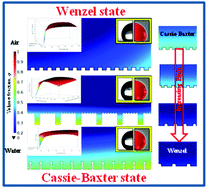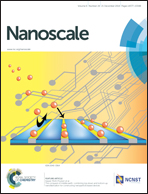Effect of topography on the wetting of nanoscale patterns: experimental and modeling studies†
Abstract
We investigated the influence of nanoscale pattern shapes, contours, and surface chemistry on wetting behavior using a combination of experimental and modeling approaches. Among the investigated topographical shapes, re-entrant geometries showed superior performance owing to their ability to restrain the liquid–air interface in accordance with Gibbs criteria. The wetting state is also controlled by the surface texture in addition to the surface chemistry. Topographies with smaller intrinsic angles are better able to support the liquid droplet. Based on these observations, two geometrical relationships for designing superhydrophobic patterns exhibiting the Cassie–Baxter state are proposed. A detailed analysis of the simulation results showed the presence of viscous forces during the initial transient phase of the droplet interaction with the solid surface even at negligible normal velocity, which was verified experimentally using a high-speed imaging technique. During this transient phase, for a polystyrene surface, the liquid front was observed to be moving with a radial velocity of 0.4 m s−1, which gradually decreased to almost zero after 35 ms. We observed that the viscous energy dissipation density is influenced by the surface material and topography and the wetting state. The viscous energy dissipation density is minimal in the case of the Cassie–Baxter state, while it becomes quite significant for the Wenzel state. The viscous effects are reduced for topographies with smooth geometries and surfaces with high slip length.


 Please wait while we load your content...
Please wait while we load your content...